Knee Pain When Bending: Causes, Symptoms & Treatments
In this article, Dr Foo outlines the common causes of knee pain when bending, with practical tips on recognising symptoms, exploring treatment options, and knowing when to seek medical attention.
MBBS (University of London) | MMed (Ortho) | FRCSEd (Ortho) | FAMS (Ortho)


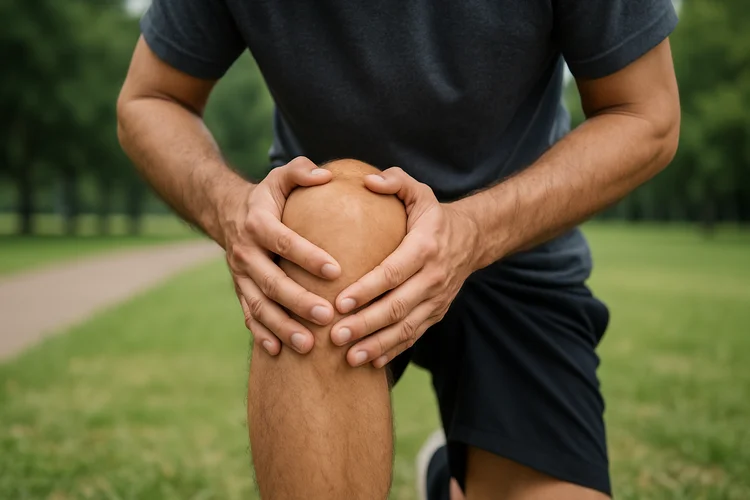
Knee pain when bending is a common but disruptive issue that can affect
simple daily activities such as squatting, climbing stairs, kneeling, or standing up from a
chair. The pain may be sharp, dull, or aching, and can occur in the front, back, or sides of
the knee. It can make routine movement uncomfortable or difficult, impacting work,
exercise, and overall mobility.
Common causes include structural injuries, overuse, degenerative changes, or muscular
imbalances. While knee pain may not always indicate a serious problem, if it interferes with
your daily life, it is advisable to consult a knee
specialist for proper assessment and care.
In this article, we outline the most common causes of knee pain when bending, symptoms that
may warrant medical attention, available treatment options, and practical strategies to help
prevent pain and protect your knee health over the long term.
What Causes Knee Pain When Bending?
Knee pain when bending can result from structural damage, overuse injuries, degenerative
changes, or biomechanical imbalances affecting the joint.
Common causes include:
1. Patellofemoral Pain Syndrome (PFPS)
Patellofemoral Pain Syndrome is caused by irritation of the cartilage on the underside of the
kneecap, often related to poor patellar tracking within the femoral groove.
It typically causes a dull, aching pain around or behind the kneecap, especially during activities
that involve repeated bending, such as squatting, stair climbing, or sitting for long periods.
Contributing factors may include muscle imbalances, especially weakness in the hip or thigh muscles,
as well as poor lower limb alignment or biomechanics.
2. Osteoarthritis
Osteoarthritis involves the
gradual breakdown of the cartilage that cushions the knee joint, commonly as a result of ageing,
joint overuse, or prior injury.
It often leads to stiffness and a deep, aching pain felt throughout the joint during bending,
especially after periods of rest or inactivity.
Pain may also be accompanied by crepitus (grating sounds), reduced mobility, and swelling in later
stages.
3. Tendinopathy
Tendinopathy refers to inflammation or degeneration of the knee tendons, most often affecting the
patellar tendon (just below the kneecap) or the quadriceps tendon (just above it).
This condition typically causes sharp or localised pain at the front of the knee, which worsens with
bending under load, such as during squats, jumps, or running.
It is common in individuals who engage in repetitive, high-impact lower limb activities.
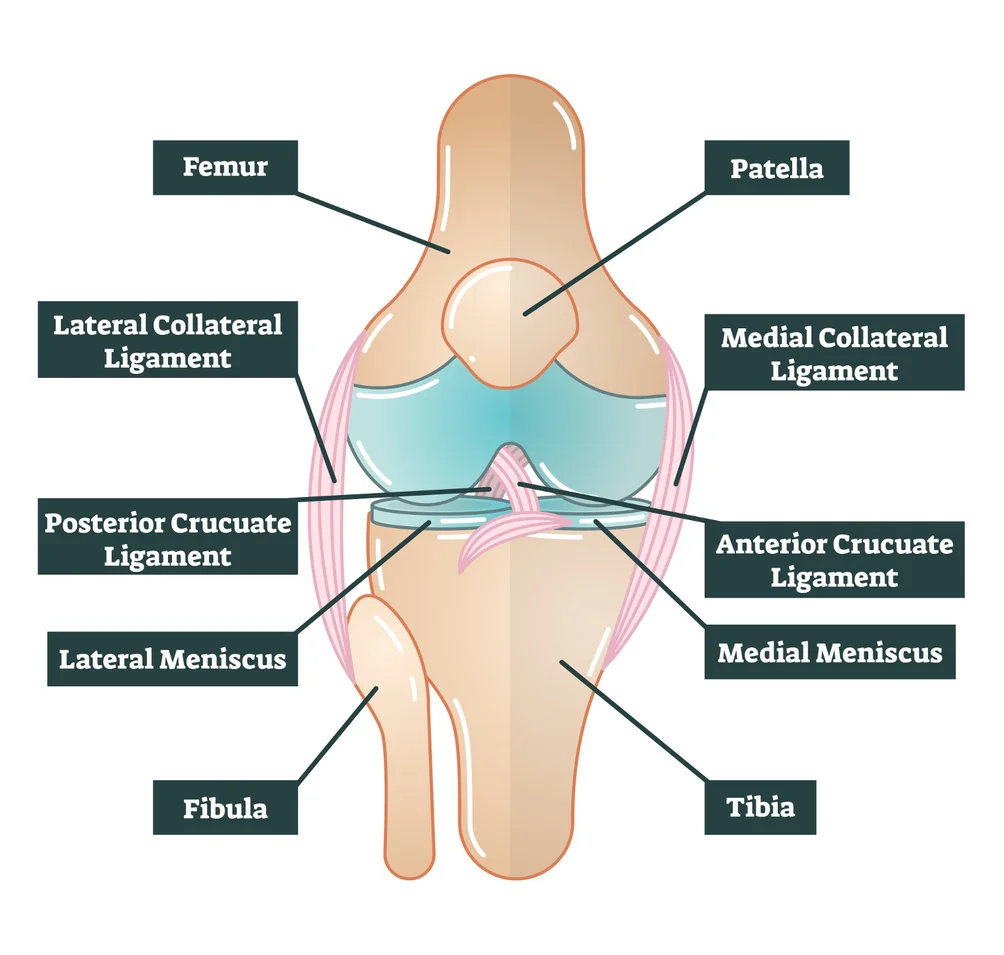
4. Meniscus Tears
A meniscus tear is damage to
one of the C shaped fibrocartilage pads, either the lateral or medial meniscus, that absorb
shock and stabilise the knee joint. Tears often result from twisting motions, deep
squatting, or directional changes.
Pain is typically sharp and located along the joint line, and may be accompanied by
catching, locking, or a sense that the knee is "giving way" during bending.
Depending on severity, meniscus tears can also lead to swelling, joint stiffness, and
reduced range of motion.
5. Ligament Injuries
Ligament injuries, such as sprains or partial tears of the anterior cruciate
ligament (ACL) or medial collateral ligament (MCL), usually result from sudden impact,
twisting, or pivoting movements.
These injuries may cause pain with bending, particularly during weight-bearing activities, along
with joint instability, swelling, and a feeling that the knee lacks support.
6. Bursitis
Bursitis refers to inflammation of one or more bursae, the fluid-filled sacs that cushion and reduce
friction between structures in the knee.
Prepatellar
bursitis (in front of the kneecap) and pes
anserine bursitis (on the inner side just below the knee) are the most common forms.
Symptoms typically include swelling, tenderness, and a burning or aching pain that worsens with
bending or kneeling. Repetitive pressure or trauma is often a contributing factor.
7. Baker’s Cyst
A Baker’s
cyst is a build-up of fluid in a bursa at the back of the knee, usually related to
underlying joint problems such as arthritis or a meniscus tear.
It can create a noticeable swelling or tightness behind the knee, which may cause a feeling of
fullness or restricted motion when bending or straightening the leg fully.
In some cases, it may cause pain radiating into the calf if the cyst presses on surrounding tissues.
Why Does Knee Pain Worsen When Squatting or Climbing Stairs?
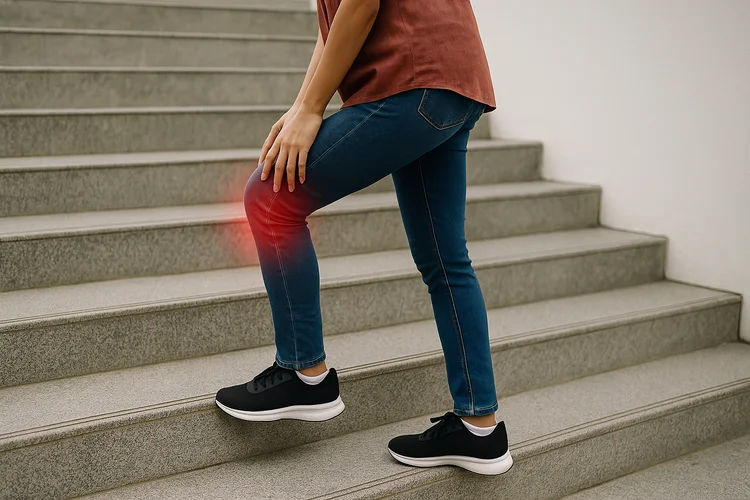
Knee pain during squatting or stair climbing often worsens because these movements increase
pressure and stress on key structures within the knee joint.
These movements place a higher load on the patellofemoral joint and the quadriceps tendon,
which can aggravate conditions such as PFPS, tendinopathy, or cartilage
degeneration.
In particular:
- Deep squatting increases pressure between the kneecap and the femur, which may irritate worn or inflamed cartilage.
- Stair climbing involves repetitive bending under load, which can intensify pain linked to joint degeneration or meniscal injury.
If you experience sharp pain, clicking, or locking during these activities, it may indicate a mechanical issue such as a meniscus tear or loose cartilage fragment interfering with joint movement.
What Are the Symptoms That Warrant Medical Attention?
Knee pain when bending warrants medical attention if it persists, worsens over time, or occurs alongside other concerning symptoms. Signs that may require further assessment include:
- Pain that persists, worsens, or interferes with daily activities
- Swelling or warmth around the knee joint
- Reduced range of motion
- Audible clicking or popping accompanied by pain
- Instability or a feeling that the knee may give way
- A locking or catching sensation during movement
- Pain that follows trauma or a sudden twisting injury
How Is Knee Pain Diagnosed?
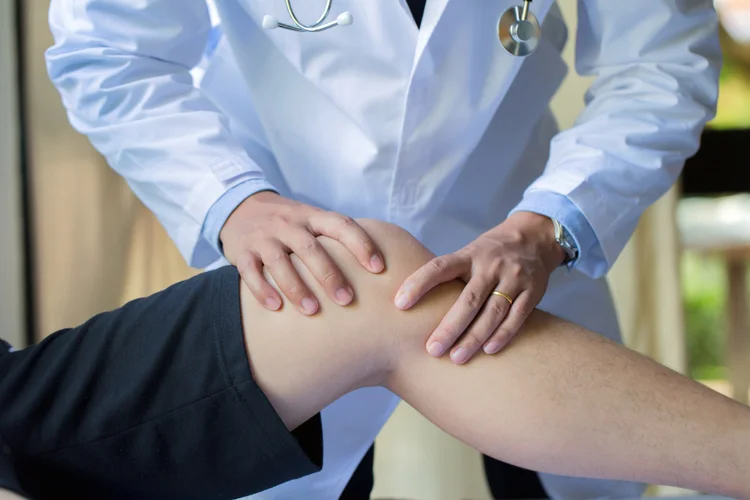
Diagnosing knee pain when bending involves a comprehensive evaluation to identify the
underlying cause through medical history review, physical examination, imaging
studies, and functional assessment.
This process helps determine the specific cause by examining the type, location, and
behaviour of the pain.
- Medical History Review – A detailed review of the onset, duration, previous injuries, aggravating activities, and other related symptoms.
- Physical Examination – Assessment includes checking for tenderness, swelling, joint stability, and movement limitations to identify signs of structural or inflammatory issues.
- Imaging – X-rays help detect bone alignment problems and signs of arthritis. MRI scans offer detailed views of soft tissues such as cartilage, ligaments, tendons, and menisci.
- Functional Assessment – Observation of how the knee moves during walking or physical activity may reveal movement patterns or muscle imbalances that contribute to the pain.
What Are the Common Treatment Options?
Treatment for knee pain when bending depends on the underlying cause, the severity of
symptoms, and the individual’s activity goals.
In most cases, conservative management is the first line of care:
| Treatment | Description & Purpose |
|---|---|
| Activity Modification | Involves changing or avoiding movements that strain the knee, such as deep squats or kneeling, to reduce joint pressure and prevent aggravation of pain during bending. |
| Physiotherapy | Structured exercises that strengthen muscles, improve joint alignment and flexibility, and support better knee mechanics to relieve pain during bending. |
| Manual Therapy | Uses hands-on techniques like joint mobilisation and soft tissue manipulation to ease stiffness, improve movement, and reduce discomfort when bending the knee. |
| Bracing or Taping | Provides external support to stabilise the knee and guide proper alignment during movement, which can reduce strain and help manage bending-related pain. |
| Medication | Non-steroidal anti-inflammatory drugs (NSAIDs) can help relieve pain and swelling in the knee, making bending and daily movement more comfortable. |
| Injection Therapy | Corticosteroid or hyaluronic acid injections may reduce inflammation or improve joint lubrication, helping to ease pain during bending in cases of persistent symptoms or osteoarthritis. |
If symptoms do not improve with conservative treatment, further options such as minimally invasive arthroscopy may be explored to address structural issues within the knee.
How Can You Prevent Knee Pain When Bending?
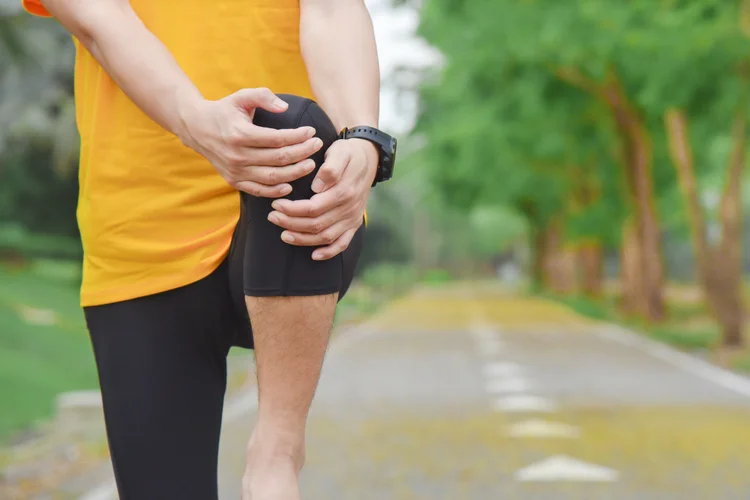
Preventing knee pain involves protecting joint health through proper movement
habits, balanced loading, and early management of contributing factors.
The following strategies may help reduce your risk of developing pain when bending:
- Strengthen key muscle groups, particularly the quadriceps, hamstrings, and glutes, to support knee stability and improve joint control.
- Use proper technique during movements like squats and lunges to minimise joint strain and lower the risk of injury.
- Maintain a healthy body weight to reduce excessive stress on the knee joint over time.
- Address minor pain or stiffness early to prevent it from progressing into a more persistent or chronic issue.
- Warm up before exercise and cool down with mobility or stretching exercises to prepare your joints for movement and aid in recovery.
- Limit repetitive high-impact activities if you are already experiencing discomfort, to prevent further irritation or overload.
- Wear supportive, well-fitted footwear that encourages proper lower limb alignment and helps reduce uneven pressure through the knees.
If you have a previous knee injury or a known joint condition, consider working with a physiotherapist or sports medicine professional to create a personalised prevention plan suited to your needs and activity level.
Every patient deserves a treatment plan tailored to their needs. We start with non-surgical approaches before considering more invasive interventions.
Find a Knee Doctor & Specialist Near Me
Apex Novena
admin@apexsportsclinic.sg
101 Irrawaddy Rd, #18-12 Royal Square Medical Centre, Singapore 329565
Nearest MRT: NS20 Novena
Apex East Coast
admin@apexsportsclinic.sg
112 E Coast Rd, #03-03/04 i12 Katong, Singapore 428802
Nearest MRT: TE26 Marine Parade
Why Do Patients Choose Apex Sports Clinic?
Sports Doctor in Singapore: Personalised & Affordable Care
Progressive Treatment Philosophy
We prioritise personalised, non-invasive solutions, progressing to specialised treatments, including surgery, only when needed for more effective and targeted care.
Holistic Patient-Centred Care
From diagnosis to rehabilitation, we provide comprehensive and seamless care for a wide range of orthopaedic conditions.
Specialist in Sports Orthopaedics & Injury Management
We combine expert injury management with a proactive approach to maintaining your body’s strength and function, so you can recover fully and perform at your peak.
Patient Journey
1 . Schedule Your Appointment

2 . Expert Diagnosis & Consultation

3 . Customised Treatment Plan

Schedule an Appointment

Our Insurance Partners






Frequently Asked Questions (FAQs)
Pain in the back of the knee when bending is commonly caused by a Baker’s cyst, hamstring tendinopathy, or a meniscal injury. A Baker’s cyst may create a sense of tightness or swelling during flexion, while tendon strain or cartilage damage can cause sharp or localised discomfort. If the pain persists, worsens, or interferes with daily activities, it is advisable to seek medical attention for appropriate diagnosis and management.
Outer knee pain when bending is commonly associated with iliotibial band syndrome, lateral meniscus tears, or lateral collateral ligament strain. These conditions can produce sharp or aching discomfort on the outside of the knee, particularly during squatting or twisting. The pain may be linked to overuse, alignment issues, or previous injury. If the pain persists, worsens, or affects your mobility, it is advisable to seek medical attention for a proper diagnosis.
Pain above the kneecap when bending can often be due to quadriceps tendinopathy or strain of the quadriceps tendon. This condition typically causes discomfort during load-bearing activities such as squats or stair climbing and may result from overuse or muscle imbalance. If the pain above the kneecap persists, worsens, or limits your ability to bend the knee, it is advisable to seek medical attention for a proper diagnosis.
Stage 1 knee arthritis is the earliest phase of osteoarthritis, involving minor joint changes with little or no visible cartilage damage on imaging. Symptoms are often minimal or absent, though some people may notice occasional stiffness or mild discomfort during activity or bending. At this stage, early lifestyle changes such as exercise, weight management, and joint-friendly habits can help slow disease progression and maintain knee function.
To loosen a stiff knee, try gentle mobility exercises, stretching, and heat application can help improve circulation and joint flexibility. Movements such as heel slides, knee extensions, and supported squats may restore range of motion, particularly after inactivity or injury. If stiffness does not improve or is accompanied by pain, it is advisable to seek medical evaluation to identify any underlying cause and receive appropriate guidance.
You should go to a doctor if it hurts to bend your knee and the pain is persistent, worsening, or accompanied by swelling, locking, or instability. These symptoms may indicate a structural injury or an underlying joint condition such as a meniscus tear or arthritis. You can consider consulting a physiotherapist or knee specialist who specialises in movement-related conditions and conservative treatment approaches.
Pain when bending a bruised knee is usually caused by soft tissue swelling, inflammation, or tenderness from the impact. Mild bruising often improves with rest, ice, and gentle movement, but persistent or worsening pain may suggest deeper tissue involvement such as joint capsule irritation or a bone bruise. It is advisable to seek medical evaluation if the pain limits mobility, affects weight-bearing, or does not improve over time.
Pain after hitting the kneecap may result from a contusion, patellar bursitis, or, in some cases, a fracture. If the pain is sharp, accompanied by swelling, or makes bending difficult and interferes with daily activities, it may suggest structural injury. If you experience these symptoms, it is advisable to seek medical assessment to determine the severity and guide appropriate treatment.
Fixing knee pain when bending depends on identifying the underlying cause, such as cartilage irritation, tendon strain, or biomechanical imbalance. You can start with rest, ice, and gentle stretching to reduce inflammation and ease discomfort. If pain persists despite these measures, it may indicate a more significant issue. It is advisable to seek medical assessment for a proper diagnosis and appropriate treatment.
Knee pain may be serious if it is severe, persistent, or associated with swelling, locking, instability, or reduced range of motion. These symptoms can indicate underlying conditions such as a meniscus tear, ligament injury, or joint degeneration. If you experience any of these signs, it is advisable to seek medical evaluation to determine the cause and whether imaging or further treatment is needed.
Knee pain can improve with targeted exercise, especially when related to muscle weakness, poor joint mechanics, or early degenerative changes. Strengthening, stretching, and mobility exercises can reduce joint strain and support better function. However, if pain persists or worsens, it may indicate a structural issue that requires medical evaluation to determine whether more specific treatment is needed.
Walking can be beneficial for knee pain when done at a suitable intensity and under the right conditions. It helps maintain mobility, strengthen muscles, and reduce stiffness in many non-acute cases. However, if pain worsens during or after walking, it may indicate inflammation or structural issues. It is advisable to consult a physiotherapist or orthopaedic specialist to determine whether walking is appropriate for your condition.
Knee pain may go away on its own if it is mild, caused by temporary strain, and not associated with structural damage. However, persistent, worsening, or recurring pain could signal underlying conditions such as tendinopathy, arthritis, or a meniscus injury that require intervention. Ignoring symptoms can lead to delayed recovery or further joint stress. Consulting a physiotherapist or knee specialist can help determine the cause and whether treatment is needed.
Red flags in knee pain include significant swelling, sharp or locking pain, instability, visible deformity, or inability to bear weight. Pain following trauma, especially with a popping sensation or rapid swelling, may also indicate serious injury. These signs may point to ligament tears, fractures, or infections. It is advisable to seek medical attention if any of these symptoms are present, to ensure timely diagnosis and appropriate care.
The four stages of knee osteoarthritis range from mild to severe. Stage 1 involves minimal cartilage loss with little or no pain. Stage 2 brings mild pain and stiffness after activity. Stage 3 is marked by frequent pain, swelling, and reduced mobility. Stage 4 involves severe pain and joint deformity due to bone-on-bone contact. However, not all knee pain follows this progression, and symptoms can vary based on the underlying cause.
Pain when bending the knee after a fall may indicate bruising, ligament strain, or in some cases, more serious injuries such as a meniscus tear or fracture. If the pain is sharp, limits movement, or is accompanied by swelling, instability, or bruising, further evaluation is warranted. It is advisable to seek medical attention to help determine if imaging or follow-up treatment is required.
Knee pain when bending inwards or sideways may indicate ligament strain, cartilage irritation, or poor joint alignment during movement. If the pain is persistent, worsens with activity, or interferes with daily function, it may suggest underlying instability or structural issues. In such cases, it is advisable to seek medical attention for proper diagnosis and appropriate treatment.
Knee pain when bending and straightening can result from various causes, including patellofemoral pain syndrome, tendon irritation, or a meniscus injury that interferes with smooth joint motion. The discomfort often arises from stress on inflamed or damaged tissue during movement. If the pain persists, worsens, or disrupts daily activities, it is advisable to seek medical attention for proper diagnosis and treatment.

